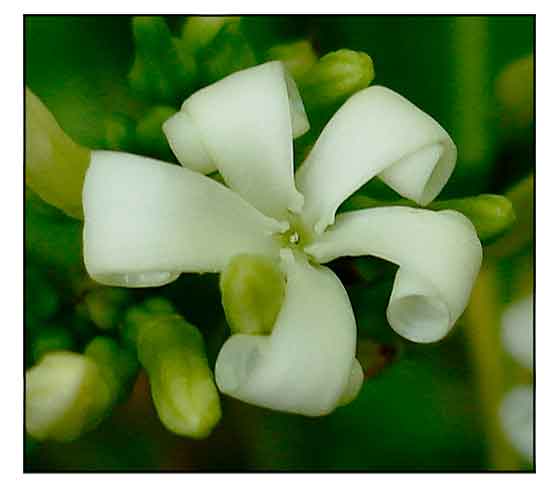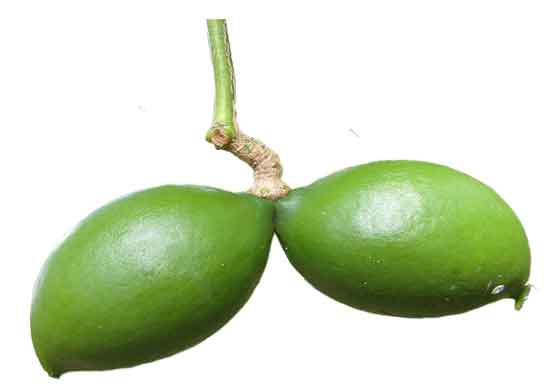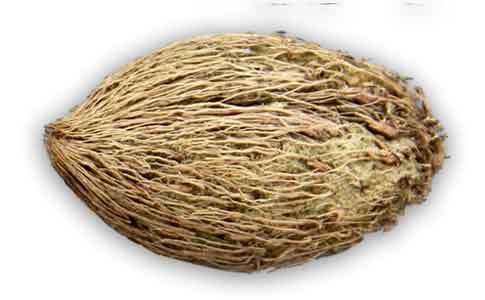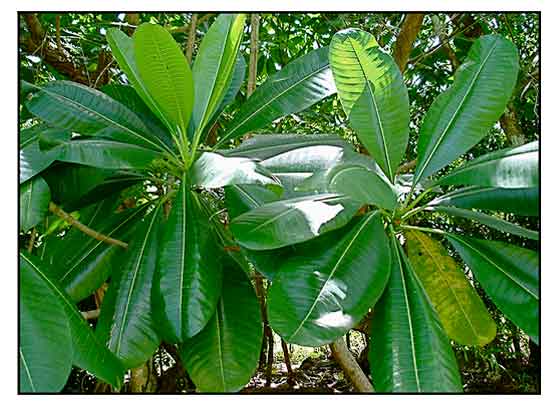 Gen info Gen info
- Apocynaceae family, also known as the periwinkle or dogbane family, contains about 400 genera and 1500 species of trees, shrubs, herbs, or climbers.
-
Ochrosia is a genus of flowering plants in the family Apocynaceae. It was first described in 1789.
- Etymology: The genus Ochrosia derives from Greek, meaning 'pale-yellow', referring to the whitish flowers. The specific epithet derives from Latin oppositifolia, meaning 'leaves arranged in pairs, opposite to each other on the stem', referring to the leaf arrangement in this species. (2)
Botany
• Growth form: A tree, up to 60 m tall, with white, milky latex when bruised. Foliage: Leaves are 3 - 5 whorled, spoon-shaped and rarely elliptic. They are between 6.5 - 36 cm long by 3.4 - 18 cm wide. Each leaf has 21 - 42 pairs of secondary veins which form a distinct submarginal vein that is close to the leaf margin. Flowers: Occurring in whorls of 2 - 4, inflorescence can reach 2 - 17 cm long and comprises of more than 30 flowers in each inflorescence. Flowers are whitish or yellowish white, tubular and 5-petalled. They are glabrous outside and covered with short dense hairs on the inside. Fruit: Fruit comprises of 2 oval to elliptic (sometimes almost round), single-seeded capsule which ripens from green to yellow or orange. (2)
 • Shrub or tree to 10 m tall. Branchlets glabrous, angled; when older bearing elongated lenticels. Leaves in whorls of 3 or opposite; petiole 1.8–5 cm long; blade subcoriaceous to coriaceous, spathulate, 5.5–27 x 3.5–11.9 cm, apex rounded to obtuse sometimes apiculate, base cuneate; major secondary veins with weaker parallel veins 15–28 pairs; glabrous. Inflorescence axillary and terminal; flowers clustered; 3.6–12.6 cm long; glabrous; pedicels 1.8–4.6 mm long. Sepals ovate, 1.6–2.2 x 0.7–1.6 mm, apex obtuse; glabrous. Corolla white; tube 4–5.1 mm long; lobes 4.3–6.5 mm long; glabrous outside, pubescent inside. Stamens inserted at 3.3–3.5 mm from corolla base; filaments 0.5–0.7 mm long; anthers 1.2–1.4 x 0.4–0.5 mm. Disk 0.2 mm long. Ovary 0.8–1 mm long; style + pistil head 1.1–2.6 mm long. Fruits ovoid; 6.1–7 cm long, 3.2–4 cm diameter. Seeds ca 3.8 x 2.5 x 1.3 cm. (Flora of Thailand) (3) • Shrub or tree to 10 m tall. Branchlets glabrous, angled; when older bearing elongated lenticels. Leaves in whorls of 3 or opposite; petiole 1.8–5 cm long; blade subcoriaceous to coriaceous, spathulate, 5.5–27 x 3.5–11.9 cm, apex rounded to obtuse sometimes apiculate, base cuneate; major secondary veins with weaker parallel veins 15–28 pairs; glabrous. Inflorescence axillary and terminal; flowers clustered; 3.6–12.6 cm long; glabrous; pedicels 1.8–4.6 mm long. Sepals ovate, 1.6–2.2 x 0.7–1.6 mm, apex obtuse; glabrous. Corolla white; tube 4–5.1 mm long; lobes 4.3–6.5 mm long; glabrous outside, pubescent inside. Stamens inserted at 3.3–3.5 mm from corolla base; filaments 0.5–0.7 mm long; anthers 1.2–1.4 x 0.4–0.5 mm. Disk 0.2 mm long. Ovary 0.8–1 mm long; style + pistil head 1.1–2.6 mm long. Fruits ovoid; 6.1–7 cm long, 3.2–4 cm diameter. Seeds ca 3.8 x 2.5 x 1.3 cm. (Flora of Thailand) (3)
Distribution
- Native to the Philippines.(1)
- Also native to Andaman Is., Bismarck Archipelago, Borneo, Cambodia, Caroline Is., Chagos Archipelago, China Southeast, Cocos (Keeling) Is., Fiji, Gilbert Is., Jawa, Laccadive Is., Line Is., Malaya, Maldives, Maluku, Marianas, Marshall Is., New Caledonia, New Guinea, Nicobar Is., Niue, Samoa, Seychelles, Society Is., Solomon Is., South China Sea, Sri Lanka, Sulawesi, Sumatera, Thailand, Tokelau-Manihiki, Tonga, Tubuai Is., Tuvalu, Vanuatu, Vietnam, Wallis-Futuna Is. (1)
- In primary or old secondary forests, hill slopes, river margins, and swamps.
- Seeds dispersed by sea.
 Constituents Constituents
- Study of bark isolated three known indole alkaloids: isoreserpiline, neisosposinine, and reserpinine. (see study below) (4)
- Literature search on Ochrosia oppositifolia revealed presence of isoreserpiline (1), neisosposinine (2), reserpinine (3), 9-methoxyellipticine (4), 10-hydroxyapparacine (5), 10-methoxyapparacine (6), ochropposinine (7), isoreserpinine (8), ochrolifuanine (9), 10-methoxydihydrocorynantheol (10), and 10-methoxycorynantheol (11). (7)
- Study isolated two ferulic acid esters: (E)-methyl 3-(4'-hydroxy-3',5'dimethoxyphenyl) acrylate (1) and (E)-methyl 18-((E)-3-(4’-hydroxy-3’methoxyphenyl) acryloyloxy)octadec-3-enoate) (2). (see study below) (8)
- Study of methanolic extract of leaves isolated two alkaloids: 10-methoxy and 10-hydroxy derivatives of apparicine. (9)
- Study of bark of Neisosperma oppositifolia yielded two new ß-carbonine indole alkaloids, oppositinines A and B (1 and 2), along with five known alkaloids, isoreserpiline, isocarapanaubine, vobasine, 10-methoxydihydrocorynantheol-N-oxide, and ochrop-posinine oxindole. (see study below) (10)
Properties
- Considered carminative; abortifacient in high doses. (2)
- Its abundance in some places may be attributed to the strong and objectionable odor produced by the profule foliage and bark, which may deter herbivores from feeding on the species.
- Studies suggest antiplasmodial, antibacterial, corrosion inhibitory, antioxidant, antimicrobial, vasorelaxant properties.
Parts used
Bark, stem-bark, leaves.
 Uses Uses
Edibility
- Fruit contains two flat, edible seeds with a taste akin to coconut.
Folkloric
- In the Vietnamese folk medicine, used for treatment of fever and stomach problems. (2)
- Root decoction drunk for bilious disorders.
- Roots taken as antidote for eating poisonous fishes and crustaceans. In Seychelles, bitter bark decoction taken to purify the blood; also as appetizer, purgative, and carminative, and in high doses as abortifacient. Decoction of leaves used to wash abdomen of women after childbirth. Local people in Acheh use decoction of stem-bark to treat malaria. (5)
- The bark was used in
ancient Hawaii to treat cancer. (9)
Others
- Wood: Yellowish-white wood is hard; used for construction. (12)
- Fuel:
Used as firewood.
- Wadding: Silky down of the fruit yields a substance used for packing and stuffing. (12)
Studies
• Antiplasmodial Activity / Indole Alkaloids / Bark: Study of bark isolated three known indole alkaloids: isoreserpiline, neisosposinine, and reserpinine. Among the crude extracts of O. oppositifolia, the dichloromethane crude extract of bark showed most potent activity against Plasmodium flaciparum with IC50 of 0.05051 µg/mL. (4)
• Antibacterial Alkaloids / Leaves, Stem Bark, Roots: Study evaluated the antibacterial activity of alkaloids from stem bark, leaves and roots using disc diffusion and MIC methods. Highest inhibitory diameters were shown by 10 mg/mL extracts of leaves and stem-bark against Staphylococcus aureus and the roots against MRSA at 10.0, 10.5 and 14.0 mm. MICs of leaf and stem-bark extracts against Bacillus subtilis, Salmonella typhimurium and Serratia marcescens and root extract against Vibrio fluvialis were 3.75, 0.94, and 0.12 mg/mL. (5)
• Green Corrosion Inhibition / Isoreserpiline / Leaves and Bark: Study evaluated alkaloid extracts of leaves (OOL) and bark (OOB) of Ochrosia oppositifolia, along with the major alkaloid isolated, isoreserpiline (ISR) as potential corrosion inhibitors for mild steel (MS) in 1 M HCl medium. SEM observations confirmed existence of an adsorbed protective film of green inhibitors, with adsorption that follow the Langmuir adsorption isotherm. FTIR and molecular modeling studies revealed the presence of ISR may be responsible for the corrosion inhibition potential of OOL and OOB. (6)
• Antioxidant / Antimicrobial / Ferulic Acid Esters: Study isolated two ferulic acid esters: (E)-methyl 3-(4'-hydroxy-3',5'dimethoxyphenyl) acrylate (1) and (E)-methyl 18-((E)-3-(4’-hydroxy-3’methoxyphenyl) acryloyloxy)octadec-3-enoate) (2). Compounds 1 and 2, and the crude methanol and hexane extracts of Ochrosia oppositifolia exhibited moderate invitro antioxidant and antimicrobial activity. (8)
• Vasorelaxant / Oppositinines Alkaloids / Bark: Study of bark of Neisosperma oppositifolia yielded two new ß-carbonine indole alkaloids, oppositinines A and B (1 and 2), along with five known alkaloids, isoreserpiline, isocarapanaubine, vobasine, 10-methoxydihydrocorynantheol-N-oxide, and ochrop-posinine oxindole. Oppositinines A and B showed potent vasorelaxant effects on rat aorta. (9)
Availability
Wild-crafted. |

![]()





 Constituents
Constituents
